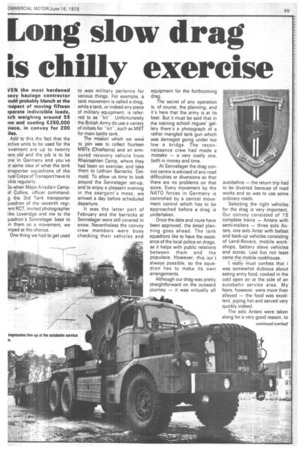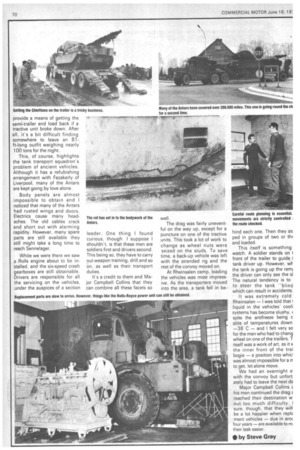Long slow drag is chilly exercise
Page 71

Page 72

If you've noticed an error in this article please click here to report it so we can fix it.
LIEN the most hardened Davy haulage contractor ould probably blanch at the vspect of moving fifteen Iparate indivisible loads, ich weighing around 55 ins and costing £250,000 3iece, in convoy for 200 lies.
Add to this the fact that the active units to be used for the ovement are up to twenty iars old and the job is to be )ne in Germany and you've )t some idea of what the tank ansporter squadrons of the Dyal Corps of Transport have to ckle regularly.
3o when -Major Al i sd a r CampAl Collins, officer commandg the 3rd Tank transporter juadron of the seventh regient RCT, invited photographer like Loveridge and me to the juadron's Sennelager base to in them on a movement, we roped at the chance.
One thing we had to get used to was military parlance for various things. For example, a tank movement is called a drag, while a tank, or indeed any piece of military equipment, is referred to as "kit". Unfortunately the British Army do use a variety of initials for "kit", such as MBT for main battle tank.
The mission which we were to join was to collect fourteen lV1BTs (Chieftains) and an armoured recovery vehicle from Rheinsahlen Camp, where they had been on exercise, and take them to Lothian Barracks, Detmold. To allow us time to look around the Sennelager set-up, and to enjoy a pleasant evening in the seargent's mess, we arrived a day before scheduled departure.
It was the latter part of February and the barracks at Sennelager were still covered in snow. Nevertheless the convoy crew members were busy checking their vehicles and equipment for the forthcoming drag.
The secret of any operation is, of course, the planning, and it's here that the army is at its best. But it must be said that in the training school rogues' gallery there's a photograph of a rather mangled tank gun which was damaged going under too low a bridge. The reconnaissance crew had made a mistake — a very costly one, both in money and time.
At Sennelager the drag control centre is advised of any road difficulties or diversions so that there are no problems on that score. Every movement by the NATO forces in Germany is controlled by a central movement control which has to be approached before a drag is undertaken.
Once the date and route have been approved, the detail planning goes ahead. The tank squadrons like to have the assistance of the local police on drags, as it helps with public relations between them and the populace. However, this isn't always possible, so the squadron has to make its own arrangements.
Although our drag was pretty straightforward on the outward journey — it was virtually all autobahns — the return trip had to be diverted because of road works and so was to use some ordinary roads.
Selecting the right vehicles for the drag is very important. Our convoy consisted of 15 complete trains — Antars with semi-trailers — three solo Antars, one solo Antar with ballast and back-up vehicles consisting of Land-Rovers, mobile workshops, battery slave vehicles and stores. Last but not least came the mobile cookhouse.
I really must confess that I was somewhat dubious about eating army food, cooked in the cold open air at the side of an autobahn service area. My fears, however, were more than allayed — the food was excellent, piping hot and served very quickly indeed.
The solo Antars were taken along for a very good reason, to provide a means of getting the semi-trailer and load back if a tractive unit broke down. After all, its a bit difficult finding somewhere to leave an 81ft-long outfit weighing nearly 100 tons for the night.
This, of course, highlights the tank transport squadron's problem of ancient vehicles. Although it has a refubishing arrangement with Fazakerly of Liverpool, many of the Antars are kept going by love alone.
Body panels are almost impossible to obtain and I noticed that many of the Antars had rusted wings and doors. Electrics cause many headaches. The old cables crack and short out with alarming rapidity. However, many spare parts are still available they still might take a long time to reach Sennelager.
While we were there we saw a Rolls engine about to be installed, and the six-speed crash gearboxes are still obtainable. Drivers are responsible for all the servicing on the vehicles, under the auspices of a section leader. One thing I found curious, though I suppose I shouldn't, is that these men are soldiers first and drivers second. This being so, they have to carry out weapon training, drill and so on, as well as their transport duties.
It's a credit to them and Major Campbell Collins that they can combine all these facets so well.
The drag was fairly uneventful on the way up, except for a puncture on one of the tractive units. This took a lot of work to change as wheel nuts were seized on the studs. To save time, a back-up vehicle was left with the stranded rig and the rest of the convoy moved on.
At Rheinsalen camp, loading the vehicles was most impressive. As the transporters moved into the area, a tank fell in be hind each one. Then they stc ped in groups of two or thr and loaded.
This itself is something watch. A soldier stands on 1 front of the trailer to guide 1 tank driver up. However, wh the tank is going up the rami the driver can only see the sl The natural tendency is to to steer the tank "'blind which can result in accidents.
It was extremely cold Rheinsalen — I was told that1 liquid in the vehicles' cooli systems has become slushy, spite the antifreeze being c able of temperatures down —36 C — and I felt very so for the man who had to chang wheel on one of the trailers. T itself was a work of art, as it v the inner front of the trai bogie — a position into whicl was almost impossible for a nto get, let alone move.
We had an overnight si with the convoy but unfort ately had to leave the next da
Major Campbell Collins his men continued the drag z reached their destination w out too much difficulty. I sure, though, that they will be a lot happier when replz ment vehicles — due in aroi four years — are available to mi their task easier.
• by Steve Gray
















































































































